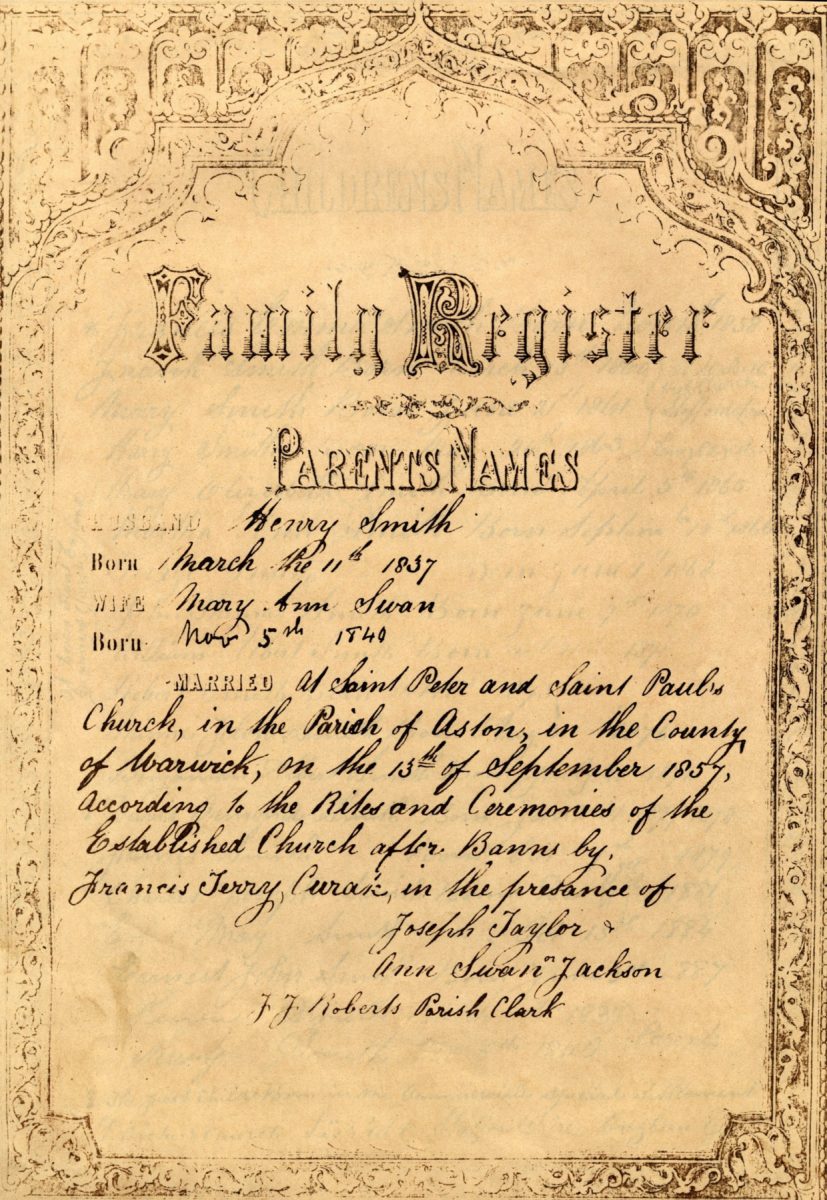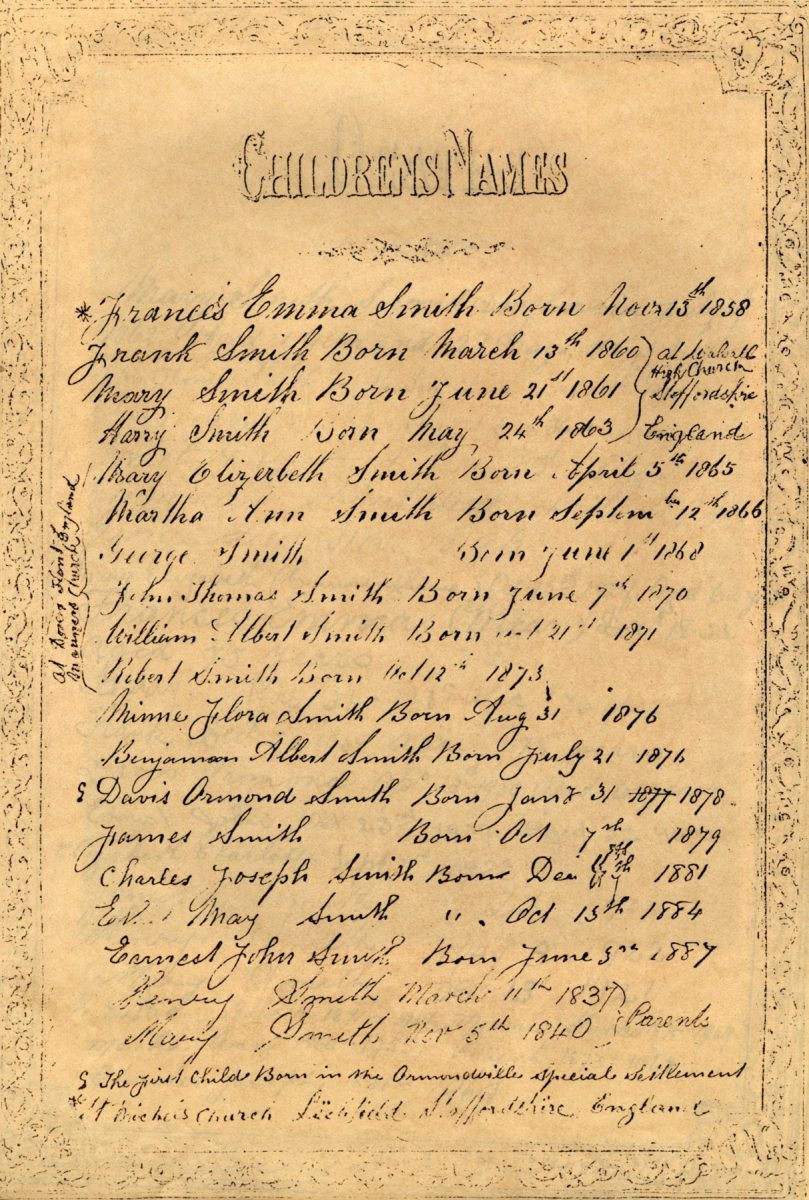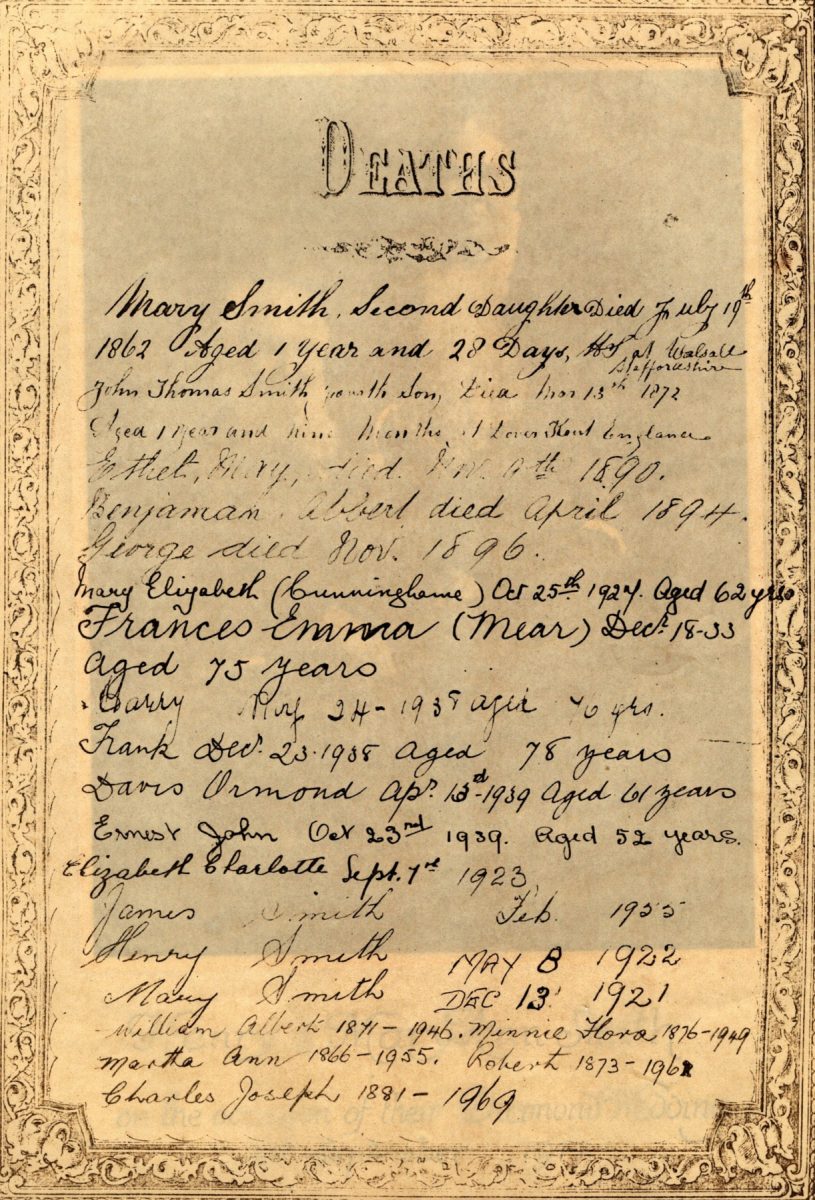- Home
- Collections
- HANNA VF
- Smith Family
Smith Family
Family Register
PARENTS NAMES
HUSBAND Henry Smith
Born March the 11th 1837
WIFE Mary-Ann Swan
Born Nov 5th 1840
MARRIED at Saint Peter and Saint Paul’s Church, in the Parish of Aston, in the County of Warwick, on the 13th of September 1857, according to the Rites and Ceremonies of the Established Church after Banns by, Francis Terry Curak, in the presance [presence] of
Joseph Taylor &
Ann Swan or Jackson
JJ Roberts Parish Clark [Clerk]

CHILDRENS NAMES
* Frances Emma Smith Born Nov 13th 1858
Frank Smith Born March 13th 1860 at Walsall High Church Staffordshire England
Mary Smith Born June 21st 1861
Harry Smith Born May 24th 1863
Mary Elizabeth Smith Born April 5th 1865
Martha Ann Smith Born September 12th 1866
George Smith Born June 1st 1868 at [?] Saint Margaret’s [?] Church England
John Thomas Smith Born June 7th 1870
William Albert Smith Born [?] 21st 1871
Robert Smith Born Oct 12th 1873
Minne Flora Smith Born Aug 31 1876
Benjamin Albert Smith Born July 21 1876
ξ Davis Ormond Smith Born Jan’y 31 1877 1878
James Smith Born Oct 7th 1879
Charles Joseph Smith Born Dec 11th [?] 1881
EV [?] May Smith Born Oct 15th 1884
Ernest John Smith Born June 3rd 1887
Parents
Henry Smith March 11th 1837
Mary Smith Nov 5th 1840
ξ The First Child Born in the Ormondville Special Settlement
* St Michael’s Church Lichfield Staffordshire England

DEATHS
Mary Smith, Second Daughter Died July 19th 1862 Aged 1 Year and 28 Days at Walsall Staffordshire
John Thomas Smith fourth Son Died Mon 13th 1872 Aged 1 year and Nine Months at Dover Kent England.
Ethel, May, died [?] 9th 1890.
Benjamin Albert died April 1894.
George died Nov. 1896.
Mary Elizabeth (Cunninghame) Oct 25th 1927. Aged 62 years
Frances Emma (Mear) Dec 18th 1933 Aged 75 years
Harry May 24 – 1938 aged 76 yrs.
Frank Dec. 23. 1938 Aged 78 years
Davis Ormond Apr. 13th – 1939 Aged 61 years
Ernest John Oct 23rd 1939. Aged 52 years.
Elizabeth Charlotte Sept. 7th 1923
James Smith Feb 1955
Henry Smith MAY 8 1922
Mary Smith DEC 13 1921
William Albert 1871-1946. Minnie Flora 1876-1949
Martha Ann 1866-1955. Robert 1873-196[?]
Charles Joseph 1881-1969

This is Lichfield Cathedral, commenced in 700 A.D and which after many renovations and restorations, stands as one of the most beautiful cathedrals in England today.
It is of particular interest to the Smith family, as Henry served as one of its Choir-boys.
Frances Emma, the eldest child, was christened in Saint Michael’s Chapel.
Mr. and Mrs. H. Smith of Terrace Road, Hastings, celebrated their diamond wedding at their residence on Thursday afternoon, when between 70 and 80 guests were entertained at an “at Home” including visitors from Wanganui, Wairarapa and Southern Hawkes Bay. Mr. and Mrs. Smith were united in the holy bonds of matrimony in St Peter and St Paul’s Church, Birmingham in 1857, the bride being a daughter of Mr. John Swan of Lichfield, and the bridegroom a son of Mr. H. Smith, of the same place. They arrived at Napier in the sailing ship “Schiehallian [Schiehallion]”, May 26th 1874, and have resided in the Domion [Dominion] ever since. For a number of years Mr. Smith has been successfully engaged in saw-milling pursuits at Makotuku, Wairarapa and on the Main Trunk Line, and was instrumental in having initiated what is now known as “Smith’s Siding” at Makotuku. He also has been connected with the dairying industry, and was one of the first to establish a dairy factory in Hawkes Bay. Mr. and Mrs Smith have a family of eight sons and four daughters, and have 126 descendants, all living in the Dominion, one son and several grandsons being on active service. The old couple, who have reached a ripe old age, are now spending the evening of their days in Hastings and are both hale and hearty. They have received the hearty congratulations of a wide circle of friends by whom they were highly esteemed.
September 13th 1917
1857 1907
Father and Mother
Request the Pleasure of your Company at the Celebration of their
Golden Wedding
on Friday afternoon, September 13th ’07, at their Residence next Webb’s Nursery, Nelson Street, Hastings.

Information from immigration records at the Hawke’s Bay Art Gallery and Museum
Smith, Henry, Farm labourer, age 36.
Address: Staffordshire
Mary, age 33
Emma, ” 15
Frank, ” 14
Mary, ” 9
Harry, ” 11
Martha, ” 7
Geo, ” 5
William, ” 2
Robert, ” 3 months
(from the Nominee Roll of Immigrants per ship Schiehallion, and the ship’s passenger list.)
Their names are also recorded in the Barrack Masters Book. After arrival at Napier they stayed at the Barracks till 30th May, along with most of the other immigrants, and then Henry was given a job described as ‘ government work’ (possibly helping make roads or railway) at the rate of 8/- per day.
The ‘Schiehallion’ was a ‘smart little iron barque of 600 tons, was built in 1869 for the Shaw-Saville Company. She had rather a short career, as she was wrecked in the English Channel when on a passage from Auckland in 1879. She visited all the principal ports in New Zealand, and on one occasion ran out to Wellington in 84 days from port to port’. (from ‘ White Wings’ by Henry Brett, published in 1924.)
On the voyage to Napier she appears to have left from London, sailing on 10th February 1874 and arriving in Napier on 26th May 1874.
Off the foot of Onepoto Gully in Napier, where Captain Cook anchored, the passengers of the ‘Schiehallion’ were disembarked. They took the long, very steep road called ‘Main Street’ to their temporary barracks on (now) Hospital Hill.
Later they left on their journey for Ormondville.
Unfortunately a picture of the ship ‘Schiehallion’ cannot be found. Have enquired from Shaw Saville, here and London, from Early Settlers Museums in our main ports, as she made a number of calls to N.Z. Even Lloyds regretted they could not supply a picture.
I don’t know whether you know anything about the conditions on these immigrant ships, such as the fact that children over 12 years of age were not allowed to travel with married couples and young children, but were put with the single people, this meant that Emma was transferred to the single women’s quarters, and Frank to the single men’s quarters. Then some of the more responsible passengers were appointed as what were called matrons and constables, to keep order and see that things ran smoothly, one presumes. They were paid for these duties and Henry Smith was appointed ‘water closet constable’, the most humble and objectionable job on board, for which duty he earned £5 for the voyage. The cost of the passage for the whole family was £107:5:0 of which Henry Smith paid £15 in promissory notes. A note in pencil beside this latter figure says “not enough”.
The information in the last paragraph was taken from the ship’s passenger list and some miscellaneous papers attached to it.
The History Department of the Auckland Library has this to say about the way of travelling in the old days. From 1872 they travelled from Napier to Dannevirke by both horse team and bullock wagon. They left Napier by a five horse team and travelled as far as Te Aute, where they stayed the night.
The next days’ travelling took them to Waipukurau where they stayed the night in the Tavis-stock [Tavistock] Hotel Stables. The third night was spent at the old Railway Hotel stables situated five miles out of Norsewood. The horses could go no further than this, so the men walked and the bullock wagons took over. The next stop before Dannevirke was at Te Whiti clearing. So it was a journey of five days.

In a book on early Ormondville, ‘Pilgrimage’ by Alice Webb (A.H & A.W Reed) Canon Webb thanks Mr. & Mrs. Plank for their welcome gifts of vegetables each week. His section has not yet been cleared of logs.
He also mentions that his neighbours, the Henry Smith’s have moved to their big house down the road.
This could have been the occasion when the group photograph of 1886 was taken – it was also Mary Elizabeth’s 21st birthday year.
The names ‘Winger’ and ‘List’ appear among others in the book. Many early records were lost either by floods or fires and also in the Hawkes Bay earthquake.
Mr Henry Smith, an old and respected Hawke’s Bay settler, and one of the pioneer sawmillers of the provinence [province], passed away yesterday, at the Lower Te Mata road, Havelock North, at the good old age of 85 [?] years. He owned large sawmills in Makotuku and Ormondville for many years, and he was held in general esteem for his business capacity and energy, as well for his commercial integrity and generally high character. The funeral will leave Lower Te Mata road to-morrow afternoon at 2 o’clock, for the Havelock cemetery.
Name Age
1 G’Father 49
2 G’Mother 46
3 Emma 28
4 Frank 26
5 Harry 23
6 Mary 21
7 Martha 20
8 George 18
9 Will 15
10 Bob 13
11 Ormond 8
12 Minnie 10
13 Jim 7
14 Dick 5
15 Albert 10
Baby Ethel 2
Ern ( Born later)
There are very many members of the family, to whom I wish to express my grateful thanks for their help, in bringing this Folder and the Family Tree into being. There are far too many friends to name individually – but their enthusiasm was a wonderful boost, as this has taken just a year to put together. Best wishes to all.
Napier Cathedral means much to us. Because Our parents received their first Communion there – were married there – and my sister, brother and I were christened there.
Win Smith

duf SYNDICATIONS LTD
A PRODUCTION COMPANY
P.O Box 3847
Studios and Offices :-
Commercial Travellers Bldg.
Customhouse Quay
Wellington, New Zealand
Tel. 557-762
After Hours : 758-765
787-971
Cables : Duf Wellington
15 November 1973
Miss Winifred P. Smith
16 Robins Road,
TAUPO
Dear Miss Smith,
Your letter of 23rd October has been passed on to us by the N.Z.B.C.
We were most fascinated to learn of the hundredth anniversary of your grandparents coming to New Zealand, which is upcoming next year and we know what an exciting prospect this can be – the gathering of relations and friends from all over the country and in many instances meeting branches and individuals of the family for the first time.
Unfortunately the records that we hold on behalf of the Ministry of Works and Development do not contain any reference to the people who arrived on the ship you mention. But we can suggest that you may like to contact the Turnbull Library here in Wellington. They may have information about the vessel and the people who travelled on board it.
We hope that you will be able to find some details which will be relevant to your search, but more importantly hope that the centennary [centenary] celebrations of your grandparents arriving in New Zealand will be a most enjoyable and rewarding experience.
Yours sincerely,
[signature]
Nadoo Balantine-Scott
Chief of Productions.
Family Reunion for the Smiths
The Smith family will be holding a family reunion in Napier this weekend to celebrate the arrival of Henry and Mary Ann Smith in Napier 100 years ago.
Mr and Mrs Smith arrived in the Schiehallion in May, 1874. They had 15 children – three died in infancy and 12 married and had families.
Mr Smith was one of the first to establish a dairy factory in Hawke’s Bay, and was a pioneer in the sawmill industry at Makotuku.
He also had a part in the initiation of what is now known as ‘Smith’s Siding’ at Makotuku.
Mr Smith was born in 1837, and Mrs Smith in 1840. They celebrated their diamond wedding anniversary in 1917.
1400 NAMES
There are now over 1400 names on the family tree dating from Henry and Mary Ann Smith. About 260 relatives from all over New Zealand and parts of Australia, are expected at the reunion.
They will meet at the Red Cross Hall, Napier, on Saturday morning for the initial get-together and have dinner in the War Memorial Hall, Napier, in the evening.
The visitors will join the 10 a.m service in St. John’s Cathedral on Sunday and have tea in the parish hall.
NAPIER Daily Telegraph
10th May ’74

Non-commercial use

This work is licensed under a Attribution-NonCommercial 3.0 New Zealand (CC BY-NC 3.0 NZ).
Commercial Use
Please contact us for information about using this material commercially.Can you help?
The Hawke's Bay Knowledge Bank relies on donations to make this material available. Please consider making a donation towards preserving our local history.
Visit our donations page for more information.












Do you know something about this record?
Please note we cannot verify the accuracy of any information posted by the community.